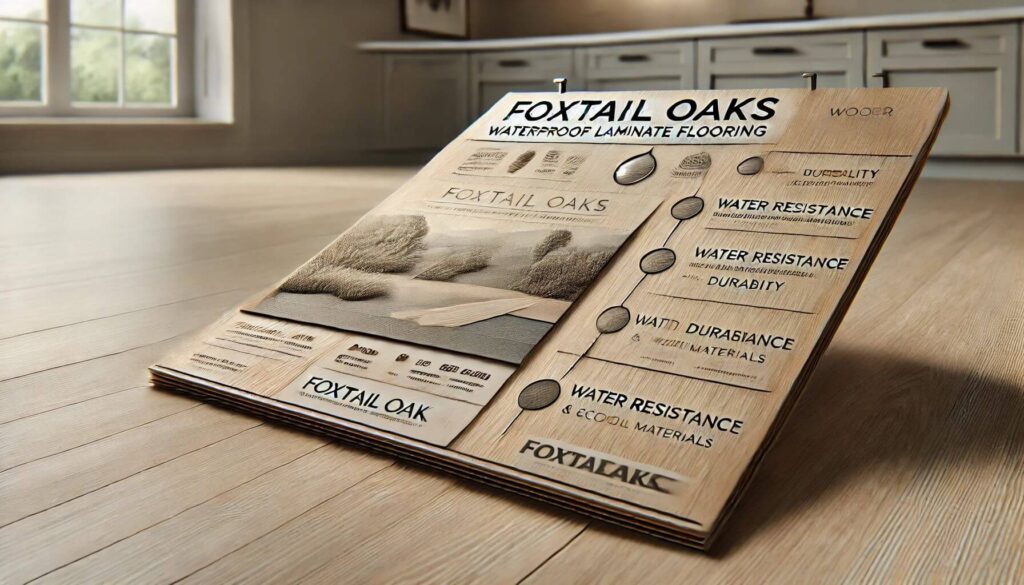
Installing Foxtail Oak laminate flooring in basements can transform these often-overlooked spaces into stylish and functional areas of your home. However, basement installations come with unique challenges due to moisture concerns and potential unevenness of the subfloor. This article will guide you through the best practices for installing Foxtail Oak laminate in basements, ensuring a beautiful and long-lasting result.
Understanding Foxtail Oak laminate
Before diving into the installation process, it’s crucial to understand the properties of Foxtail Oak laminate. Foxtail Oak waterproof laminate flooring is designed to withstand moisture better than traditional laminate, making it an excellent choice for basement installations. Its water-resistant properties provide an added layer of protection against the damp conditions often found in below-grade spaces.
Assessing basement conditions
The first step in any basement flooring project is to thoroughly assess the existing conditions. Check for any signs of water intrusion, high humidity levels, or existing floor damage. Address these issues before proceeding with the installation. Understanding crawl space moisture barriers can provide valuable insights into managing moisture in below-grade spaces, which is equally applicable to basements.
Moisture testing and mitigation
Conduct a moisture test on your concrete subfloor to ensure it’s suitable for laminate installation. Use a moisture meter to check the moisture content of the concrete. If levels are high, you may need to install a vapor barrier or take other moisture mitigation steps before proceeding. Damp proofing foundations offers additional strategies for managing moisture in basement environments.
Subfloor preparation
Proper subfloor preparation is crucial for a successful Foxtail Oak laminate installation in basements. Start by thoroughly cleaning the concrete subfloor and repairing any cracks or uneven areas. Consider using a self-leveling compound to create a smooth, level surface. This step is essential for preventing future issues with your laminate flooring.
Choosing the right underlayment
Selecting an appropriate underlayment is critical for basement installations. Look for options that offer both moisture protection and insulation. Underlayments for Foxtail Oak waterproof laminate floors can provide guidance on choosing the best option for your specific basement conditions.
Acclimation process
Before installation, it’s crucial to acclimate your Foxtail Oak laminate to the basement environment. Acclimate Foxtail Oak laminate by storing the flooring in the basement for at least 48 hours before installation. This process allows the laminate to adjust to the temperature and humidity levels of the space, reducing the risk of expansion or contraction after installation.
Installation method: glue-down vs. click-lock
When installing Foxtail Oak laminate in basements, you’ll need to choose between glue-down and click-lock installation methods. Glue-down vs click-lock Foxtail Oak laminate offers a comparison of these two approaches. In basements, glue-down installation may provide better moisture resistance, but click-lock systems offer easier installation and replacement if needed.
Proper tools and equipment

Having the right tools is essential for a professional-looking installation. Tools for a professional-looking Foxtail Oak laminate installation provides a comprehensive list of equipment you’ll need. Pay special attention to tools that help with moisture management and leveling, as these are particularly important for basement installations.
Creating expansion gaps
Remember to leave appropriate expansion gaps around the perimeter of the room and around any fixed objects like support columns. These gaps allow the Foxtail Oak laminate to expand and contract with changes in temperature and humidity, which is especially important in basement environments.
Sealing edges and transitions
Pay extra attention to sealing edges and transitions in basement installations. Use waterproof silicone caulk to seal the expansion gaps around the perimeter of the room. This extra step helps prevent moisture from seeping under the flooring. Transitioning Foxtail Oak laminate to other surfaces is crucial for a polished look and proper moisture management.
Installing baseboards and trim
Once the Foxtail Oak laminate is installed, finish the job by installing baseboards and trim. These not only provide a finished look but also help protect the expansion gaps. Baseboards for Foxtail Oak laminate floors offers guidance on selecting and installing the right baseboards for your basement project.
Moisture management post-installation
After installation, ongoing moisture management is crucial for the longevity of your Foxtail Oak laminate in the basement. Consider using a dehumidifier to control humidity levels and regularly check for any signs of water intrusion. Foxtail Oak laminate in high moisture areas provides tips for maintaining your flooring in damp environments.
Lighting considerations

Proper lighting can enhance the beauty of your new Foxtail Oak laminate floor and create a more inviting basement space. Lighting options for Foxtail Oak offers ideas for illuminating your newly floored basement effectively.
Incorporating area rugs
While Foxtail Oak laminate is durable, incorporating area rugs can add comfort and style to your basement space. Rugs for Foxtail Oak waterproof flooring provides suggestions for selecting rugs that complement your new flooring while offering additional protection.
Managing temperature fluctuations
Basements can experience significant temperature fluctuations, which can affect your Foxtail Oak laminate. Consider installing a proper HVAC system or using space heaters and fans to maintain a consistent temperature. This helps prevent excessive expansion and contraction of the flooring.
Soundproofing considerations
Installing laminate in basements can sometimes create echo or noise issues. Soundproof a room with Foxtail Oak laminate flooring offers strategies for reducing sound transmission, which can be particularly useful if your basement will be used as a living space or home theater.
Dealing with support columns
Many basements have support columns that need to be worked around during flooring installation. Create custom cuts around these columns, ensuring proper expansion gaps. Consider using decorative column wraps to seamlessly integrate these structural elements with your new flooring.
Integrating with stairs
If your basement has stairs, you’ll need to consider how to integrate them with your new Foxtail Oak laminate flooring. Foxtail Oak laminate on stairs provides guidance on extending your flooring to stairways for a cohesive look.
Creating defined spaces
Use your new Foxtail Oak laminate flooring to help define different areas within your basement. Foxtail Oak flooring in open concept space offers ideas for using flooring to create distinct zones in large, open areas.
Maintenance and cleaning
Proper maintenance is key to preserving the beauty and longevity of your Foxtail Oak laminate in the basement. Develop a regular cleaning routine using appropriate products for laminate flooring. Avoid excessive water use during cleaning to prevent moisture issues.
Addressing potential challenges
Be prepared to address common challenges that may arise during or after installation. Damaged Foxtail Oak laminate boards provides guidance on dealing with any damage that might occur during the installation process or over time.
Enhancing basement aesthetics
Once your Foxtail Oak laminate is installed, consider other ways to enhance your basement’s overall aesthetic. Design a modern home office offers ideas that can be adapted to create stylish basement spaces, whether for work or leisure.
Energy efficiency considerations
Installing Foxtail Oak laminate in your basement can contribute to improved energy efficiency. The flooring provides an additional layer of insulation, helping to regulate temperature. Consider complementing your new flooring with other energy-efficient upgrades to maximize the comfort of your basement space.
Future-proofing your installation
When installing Foxtail Oak laminate in your basement, think about future needs. Consider installing extra electrical outlets or pre-wiring for entertainment systems while the flooring is being installed. This forward-thinking approach can save time and effort if you decide to further develop your basement space in the future.
Conclusion
Installing Foxtail Oak laminate in basements requires careful planning and execution, but the results can be truly transformative. By following these best practices, you can create a beautiful, durable, and moisture-resistant floor that turns your basement into a valuable living space. Remember to prioritize moisture management, proper preparation, and ongoing maintenance to ensure the longevity of your new Foxtail Oak laminate flooring in this unique environment.



